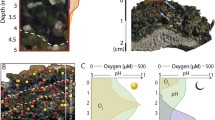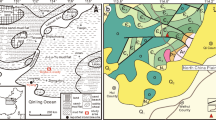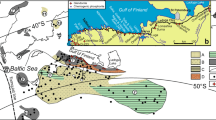Abstract
Thermophilic microbes have long been implicated in the formation of travertine and siliceous sinter. Precipitation of CaCO3 at thermal springs is induced mainly through degassing of CO2. Cyanobacteria and other bacteria can play a role in calcite and aragonite nucleation in warm (20 – 40 °C) and mesothermal (40 – 75 °C) hot springs, and through photosynthesis and other biochemical processes may mediate some mineral precipitation. Many fabrics in warm-spring and mesothermal travertines preserve evidence of microbes. Travertine precipitated at hyperthermal (> 75 °C) spring vents is mainly abiotic and commonly exhibits high-disequilibrium crystal morphologies. Silica precipitation in hyperthermal springs and geysers results mainly from rapid cooling and evaporation. Microbes, however, can play an important role by providing templates for silica nucleation and by controlling development of many sinter and geyserite fabrics.
Access this chapter
Tax calculation will be finalised at checkout
Purchases are for personal use only
Preview
Unable to display preview. Download preview PDF.
Similar content being viewed by others
References
Allen ET (1934) The agency of algae in the deposition of travertine and silica from thermal waters. Am J Sci 27: 373–389
Barns S, Nierzwicki-Bauer, SA (1997) Microbial diversity in ocean, surface and subsurface environments. In: Banfield JF, Nealson KH (eds) Geomicrobiology: interactions between microbes and minerals. Min Soc Am Rev Mineral 35: 35–79
Bock GR, Goode JA (eds) (1996) Evolution of hydrothermal ecosystems on Earth (and Mars?). Wiley, Chichester (Ciba Foundation Symposium no 202 )
Brock TD (1978) Thermophilic microorganisms and life at high temperatures. Springer, Berlin Heidelberg New York
Browne PRL, Lloyd, EF (1987) Water dominated geothermal systems and associated mineralisation. NZ Geol Sury Rec 22: 85–146
Buczynski C, Chafetz HS (1991) Habit of bacterially induced precipitates of calcium carbonate and the influence of medium viscosity on mineralogy. J Sed Petrol 61: 226–233
Cady SL, Farmer JD (1996) Fossilization processes in siliceous thermal springs: trends in preservation along thermal gradients. In: Bock GR, Goode JA (eds) Evolution of hydrothermal ecosystems on Earth (and Mars?). Wiley, Chichester (Ciba Foundation Symposium no 202 ), pp 150–173
Castenholz RW (1984) Composition of hot spring microbial mats: a summary. In: Cohen Y, Castenholz RW, Halvorsen HO (eds) Microbial mats: stromatolites. Liss, New York, pp 107–109
Chafetz HS, Folk RL (1984) Travertines: depositional morphology and the bacterially constructed constituents. J Sed Petrol 54: 289–316
Chafetz HS, Rush PF, Utech NM (1991) Microenvironmental controls on mineralogy and habit of CaCO3 precipitates: an example from an active travertine system. Sedimentology 38: 107–126
Fernandez-Diaz L, Putnis A, Prieto M, Putnis CV (1996) The role of magnesium in the crystallization of calcite and aragonite in a porous medium. J Sed Res A66: 482–491
Ferris FG, Fyfe WS, Beveridge TJ (1988) Metallic ion binding by Bacillus subtilis: implications for the fossilization of microorganisms. Geology 16: 149–152
Folk RL (1994) Interaction between bacteria, nannobacteria, and mineral precipitation in hot springs in central Italy. Géog Phys Quat 48: 233–246
Folk RL, Chafetz HS, Tiezzi PA (1985) Bizarre forms of depositional and diagenetic calcite in hot-spring travertines, central Italy. In: Schneidermann N, Harris PM (eds) Carbonate cements. Spec Publ Soc Econ Paleontol Mineral 36: 349–369
Ford TD, Pedley HM (1996) A review of tufa and travertine deposits of the world. Earth Sci Rev 41: 117–175
Fournier RO (1985) The behavior of silica in hydrothermal solutions. In: Berger BR, Bethke PM (eds) Geology and geochemistry of epithermal systems. Soc Econ Geol Rev Econ Geol 2: 45–61
Guo L, Riding R (1994) Origin and diagenesis of Quaternary shrub fabrics, Rapolano Terme, Italy. Sedimentology 41: 499–520
Jones B, Renaut RW (1995) Noncrystallographic calcite dendrites from hot-spring deposits at Lake Bogoria, Kenya. J Sed Res A65: 154–169
Jones B, Renaut RW (1996) Skeletal crystals of calcite and trona from hot-spring deposits in Kenya and New Zealand. J Sed Res A66: 265–274
Jones B, Renaut RW (1997) Formation of silica oncoids around geysers and hot springs at El Tatio, northern Chile. Sedimentology 44: 287–384
Jones B, Renaut RW (1998) Origin of platy calcite crystals in hot- spring deposits in the Kenya Rift Valley. J Sed Res 68: 913–927
Jones B, Renaut RW, Rosen MR (1996) High-temperature (gt;90 °C) calcite precipitation at Waikite Hot Springs, North Island, New Zealand. J Geol Soc Lond 153: 481–496
Jones B, Renaut RW, Rosen MR (1997a) Biogenicity of silica precipitation around geysers and hot-spring vents, North Island, New Zealand. J Sed Res A67: 88–1o4
Jones B, Renaut RW, Rosen MR (1997b) Vertical zonation of biota in microstromatolites associated with hot springs, North Island, New Zealand. Palaios 12: 220–236
Jones B, Renaut RW, Rosen MR (1998) Microbial biofacies in hot-spring sinters: a model based on Ohaaki Pool, North Island, New Zealand. J Sed Res 68: 413–434
Konhauser KO, Ferris FG (1996) Diversity of iron and silica precipitation by microbial mats in hydrothermal waters, Iceland: implications for Precambrian iron formations. Geology 24: 323–326
Leo RF, Barghoorn ES (1976) Silicification of wood. Bot Mus Leaflets Harvard Univ 25: 1–47
Love KM, Chafetz HS (1990) Petrology of Quaternary travertine deposits, Arbuckle Mountains, Oklahoma. In: Herman JS, Hubbard DA (eds) Travertine–marl: stream deposits in Virginia. VA Div Min Resour Publ 101: 65–78
Oehler JH (1976) Experimental studies in Precambrian paleontology: structural and chemical changes in blue-green algae during simulated ossilization in synthetic chert. Geol Soc Am Bull 68: 117–129
Pentecost A (1996) High temperature ecosystems and their chemical interaction with their environment. In: Bock GR, Goode JA (eds) Evolution of hydrothermal ecosystems on Earth (and Mars?). Wiley, Chichester, ( Ciba Foundation Symposium no 202 ), pp 99–111
Pentecost A, Viles H (1994) A review and reassessment of travertine classification. Géog Phys Quat 48: 305–314
Renaut RW, Jones B (1997) Controls on aragonite and calcite precipitation in hot spring travertines at Chemurkeu, Lake Bogoria, Kenya. Can J Earth Sci 34: 801–818
Renaut RW, Owen RB (1988) Opaline cherts associated with sublacustrine hydrothermal springs at Lake Bogoria, Kenya Rift Valley. Geology 16: 699–702
Renaut RW, Jones B, Tiercelin J-J (1998) Rapid in situ silicification of microbes at Loburu hot springs, Lake Bogoria, Kenya Rift Valley. Sedimentology 45: 1083–1103
Rimstidt JD, Cole RR (1983) Geothermal mineralization I: The mechanism of formation of the Beowawe, Nevada, siliceous sinter deposit. Am J Sci 283: 861–875
Schultze-Lam S, Ferris FG, Konhauser KO, Wiese RG (1995) In situ silicification of an Icelandic hot spring microbial mat: implications for microfossil formation. Can J Earth Sci 32: 2021–2026
Stetter KO (1996) Hyperthermophilic procaryotes. FEMS Microbiol Rev 18: 149–158
Trewin N (1994) Depositional environment and preservation of biota in Lower Devonian hot-springs of Rhynie, Aberdeenshire, Scotland. Trans R Soc Edin Earth Sci 84: 433–442
Walter MR (1976) Geyserites of Yellowstone National Park: an example of abiogenic,stromatolites’. In: Walter MR (ed) Stromatolites. Elsevier, Amsterdam, pp 87–112
Walter MR, Bauld J, Brock JD (1972) Siliceous algal and bacterial stromatolites in hot spring and geyser effluents of Yellowstone National Park. Science 178: 402–405
Walter MR, Bauld J, Brock TD (1976) Microbiology and morpho-genesis of columnar stromatolites (Conophyton, Vacerrilla) from hot springs in Yellowstone National Park. In: Walter MR (ed) Stromatolites. Elsevier, Amsterdam, pp 273–310
Walter MR, Desmarais D, Farmer JD, Hinman NW (1996) Lithofacies and biofacies of mid-Paleozoic thermal spring deposits in the Drummond Basin, Queensland, Australia. Palaios 11: 497–5i8
Ward DM, Tayne TA, Anderson KL, Bateson MM (1987) Community structure and interactions among community members in hot-spring microbial mats. In: Fletcher M, Gray TRG, Jones JG (eds) Ecology of microbial communities 41: 179–210
Weed WH (1889) Formation of travertine and siliceous sinter by the vegetation of hot springs. US Geol Surv, 9th Annu Rep, pp 613–676
White DE, Brannock WW, Murata KJ (1956) Silica in hot-spring waters. Geochim Cosmochim Acta 10: 27–59
Author information
Authors and Affiliations
Editor information
Editors and Affiliations
Rights and permissions
Copyright information
© 2000 Springer-Verlag Berlin Heidelberg
About this chapter
Cite this chapter
Renaut, R.W., Jones, B. (2000). Microbial Precipitates Around Continental Hot Springs and Geysers. In: Riding, R.E., Awramik, S.M. (eds) Microbial Sediments. Springer, Berlin, Heidelberg. https://doi.org/10.1007/978-3-662-04036-2_21
Download citation
DOI: https://doi.org/10.1007/978-3-662-04036-2_21
Publisher Name: Springer, Berlin, Heidelberg
Print ISBN: 978-3-642-08275-7
Online ISBN: 978-3-662-04036-2
eBook Packages: Springer Book Archive




